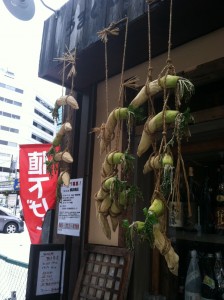Before I ever worked with forage radish as a cover crop, I knew it as the vegetable daikon, which has been grown by farmers in Asia for centuries. In fact, some of the characteristics of forage radish studied by researchers in the last twenty years were observed and noted by the Japanese farmer and no-till advocate Masanobu Fukuoka even decades before.
 Here in the states at cover crop field days, people ask “is it edible?”
Here in the states at cover crop field days, people ask “is it edible?”
Yes- and it’s delicious! People in Japan and other parts of Asia eat daikon in a multitude of ways- freshly grated, cooked, pickled. My personal favorite is hoshi daikon, which is daikon dried by a slow process often involving freezing temperatures at night and thawing during the day. The daikon at this restaurant pictured are ornamental, but illustrate the process (one method, anyway) of drying. Daikon is also nutritious, with many of the nutrients in the greens, which are also edible. I won’t delve too deeply into the nutrition–just look up glucosinolates and start gathering daikon recipes to guide you safely into old age.
This is relevant to the cover crop discussion for at least two reasons:
- Forage radish (daikon) is a multi-purpose crop that can serve as both a cover crop and, to some extent, a cash crop. Of course, some of the benefits of the cover crop would be lost if the whole field were sold, and it is unlikely you will find a market for an entire field of forage radishes in the United States. However, if the radishes are harvested in late October, they have already done their weed suppressing function, and when it comes to nutrients, even harvesting a portion of a crop can still leave a large amount of nutrients in the field for the next cash crop to use. A cover crop that brings in a little cash and feeds people as well as the soil is a great thing.
- The next great cover crop is waiting to be discovered, and may be a crop you already know. Seed price often, and rightly, discourages people from planting crops that will bring no immediate economic return. In some cases, demand can bring seed prices down. Fifty years ago, people may have looked askance at you if you planted a whole field of turnips or radishes and left them in the ground to rot over the winter. Now it’s becoming (almost) normal. Point is, there are probably more cover crops out there to “discover” and integrate into our farming systems, but somebody has to take the leap to find them and try them out!



